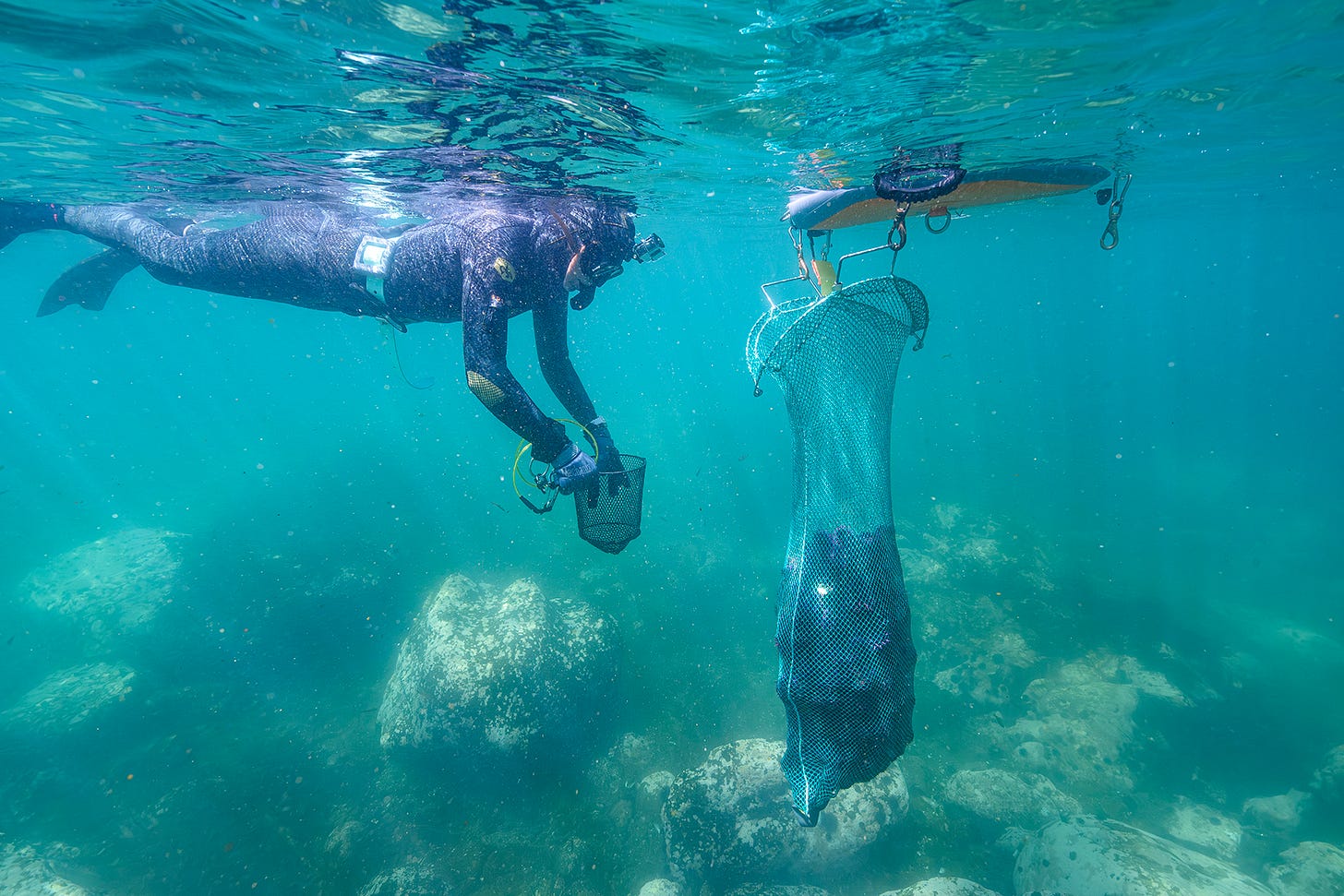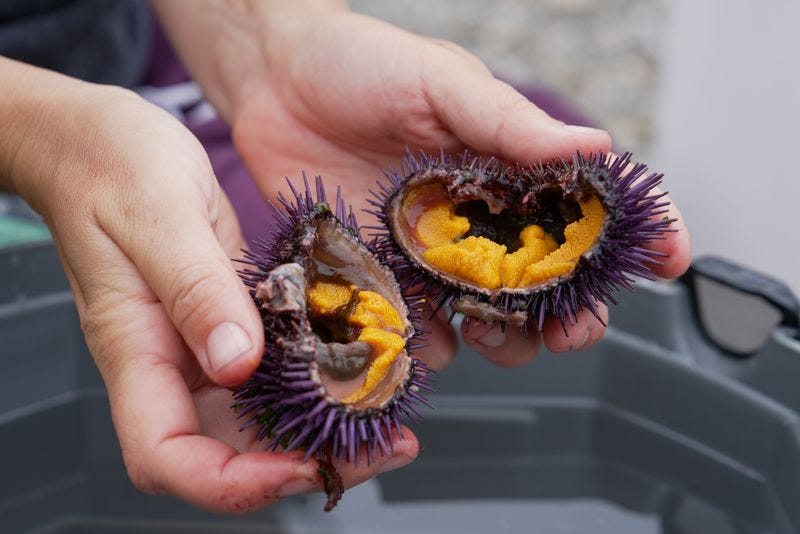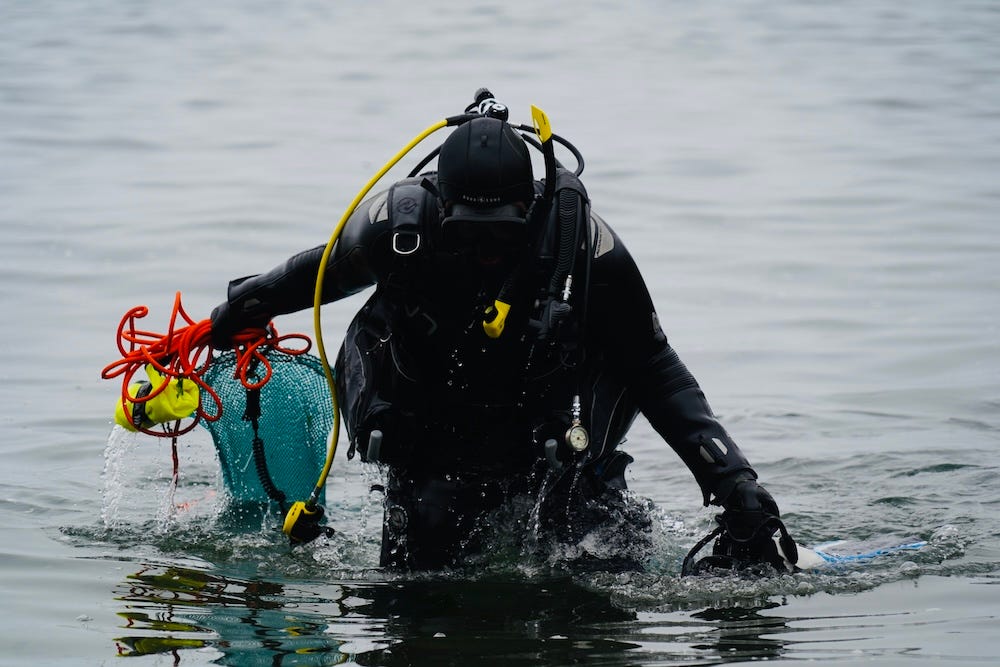The Purple Urchin Removal Project is working to save coastal kelp forests one dive at a time
On the Sonoma coast, local volunteers spend their Sundays harvesting purple sea urchins, the scourge of the Pacific Coast kelp forest

Every Sunday morning a small group of divers and eclectic Bay Area locals gathers at Stillwater Cove in Jenner. Their intent is to restore the dwindling coastal kelp forests, which they do by harvesting purple sea urchins.
Part of a little-known grassroots movement called the Purple Urchin Removal Project (PURP) started two years ago by Santa Rosa resident Eric Sedletzky, these volunteers operate with no visible hierarchy other than those with more experience explaining to those with less experience what needs to be done. The task before them is simple, herculean and deeply meaningful on a personal level. Perhaps through their efforts they can reverse an ecological crisis of incalculable magnitude.
Scuba diver John Koene, from Muir Beach, has been showing up for the past year. Before that, he volunteered for a parallel project farther up the coast—Help the Kelp—run by Josh Russo at Mendocino’s Caspar Beach.
“The state organizations aren’t really helping us out,” Koene said. “This group is organically grown. We’re coming up with our own time frames, our own equipment, and we’re giving ourselves permission to do it just the way we want to do it.”
“It feels good to be a part of something that is making an impact,” he added. “Even though at times it feels like a Sisyphean kind of exercise where you’re pushing the rock up only to see it fall back.”
Indeed, PURP’s efforts seem to be bringing the Cove’s kelp forest back. But the number of purple urchins and the size of the kelp forest fluctuate, and from one season to another, the density of the forest can differ radically, making progress difficult to define or chart.
The decline of California’s kelp forests began in 2013 with the emergence of a wasting disease that decimated the sunflower sea stars, the primary predator of purple sea urchins. Then in 2014-2015, a warmwater marine “blob” appeared off the West Coast, inhibiting kelp growth. This combination of factors resulted in an unchecked population explosion of purple urchins, which then decimated kelp forests. The North Coast was hit especially hard.
According to an article published by NASA’s Landsat Science in 2021, “Landsat Shows the Collapse of Northern California Kelp Forests,” written by Tim Stephens: “Landsat imagery shows that the area covered by kelp forests off the coast of Northern California has dropped by more than 95 percent, with just a few small, isolated patches of bull kelp remaining. Species-rich kelp forests have been replaced by “urchin barrens,” where purple sea urchins cover a seafloor devoid of kelp and other algae.”
Internationally recognized award-winning wildlife conservation photographer Joshua Asel, a Sebastopol resident, says PURP is one of a half-dozen photography projects he’s currently involved with. A diver himself, he witnessed the disappearance of the kelp forests firsthand and counts himself lucky to be part of the urchin removal project, which he chronicles with his underwater camera.
“It’s a weird thing to experience,” he said. “One year I go there [to the Sonoma Coast kelp beds] diving. I have a great time. I say, ‘All right, next year I’m doing my birthday with my buddies. Let’s go diving.’ We go. I say, ‘This place is incredible. You’ve got to check this out.’ And then there’s nothing. [The kelp forest] is a total desert.”
Local scuba diver Sedletzky began harvesting purple urchins by himself three years ago in response to his own experience watching the disappearance of the coastal kelp forests.
“I started removing urchins because there was really nothing else to do,” he said. “And it’s just kind of fun. It’s kind of addictive. It’s really like a cross of picking weeds and popping bubble wrap. You just can’t stop.”
A year into the project, realizing the scope of the task at hand required a team of people to make an impact, he contacted Santa Rosa dive shop Seals Watersports for assistance. Seals Watersports added the project, which Sedletzky decided to name PURP, to its Fun Dive email list. Now about 100 divers show interest, and 12-15 attend any given dive day.
The Sunday routine is simple enough. Divers begin arriving at 8 am and enter the water, where they spend the rest of the day alternating between removing purple sea urchins and sequestering them in net bags attached to buoys, and bringing the bags to shore.

There, other volunteers weigh the urchins, remove any inanimate materials on a sorting table and return any other living matter to the water, and dump the purple urchins in garbage cans. The garbage cans are later transported to a local ranch for composting. Volunteers begin heading home about 2 pm, some staying as late as 5 pm.
The daily individual legal catch limit for purple sea urchins has been raised to 40 gallons in recent years, due to the kelp crisis. The PURP divers measure their hauls in pounds. Sedletzky says that the total haul during the past two years, since PURP became “official,” has totaled approximately 27,000 pounds.
During the sorting process, some prized purple urchins are invariably harvested for an uni (pronounced “oo-nee”) snack. Many would say that uni, an expensive delicacy found in Japanese and Mediterranean restaurants, is an acquired taste. As Sedletzky asserts, and this reporter can testify to, it tastes like “sea avocado.” Visually, it resembles something akin to miso paste.

Katherine “Ryn” Sullivan (they/them), a PURP volunteer from Oakland and an uni aficionado, goes so far as to cook with it.
“I’m all about the uni. I’m all about helping people like it. There’s a lot of ways to eat it. There’s pastas, there’s rice bowls. Putting things with bacon is always good,” Ryn said.
“This particular project, I do free diving and then also shore support,” they added. “I’ve got a snorkel and a weight belt, and I go out and I’m doing some shallow diving. It’s hard, when you have a scuba tank, to work the shallows all the time.”
Recently, someone raised the idea of hosting an Uni Festival as a means to increase awareness of the kelp crisis. Indeed, some PURP volunteers find it baffling that 10 years after the crisis struck, most Californians don’t seem to have any awareness of the offshore kelp forest crisis affecting their coastal marine ecosystem.
“It’s not something that we’re used to,” Asel said. “And unless you truly see the effects of it with your own eyes, it’s kind of hard to care about. There’s not a lot of people that relate. ‘Oh well, who cares about an underwater desert?’ Well, you should care, because it’s going to determine the health of California’s ecosystem.”

Diver John Koene said, “It would be helpful if more people knew about this issue. And it would also be helpful if the people that are regulators would stick their head under the water and take a look.”
And so the project continues on quietly, unfunded, generally unrecognized, gathering new volunteers one at a time, generating community and meaning for the participants—and free, world-class uni—week after week, month after month, year after year.
“We have a core group of citizen volunteers,” Sedletzky said. “And kelp is beginning to return. All the sea grasses are beginning to return. There’s weeds growing. We’ve really made a difference.”
For more information about PURP, visit their Instagram and their forum on the Scubaboard community.



Hopefully the dive group has communicated w the Bodega Bay Marine Lab..They have a purple urchin program
Fascinating story! Well documented.